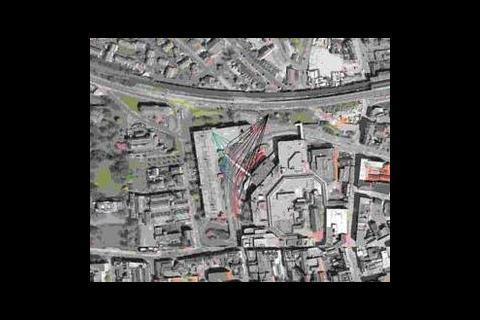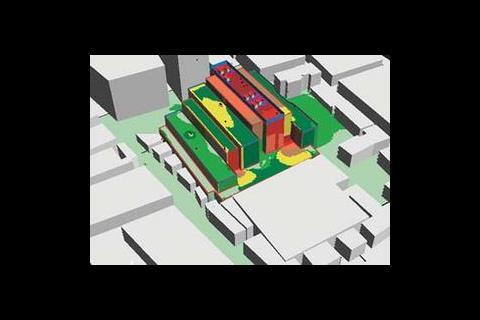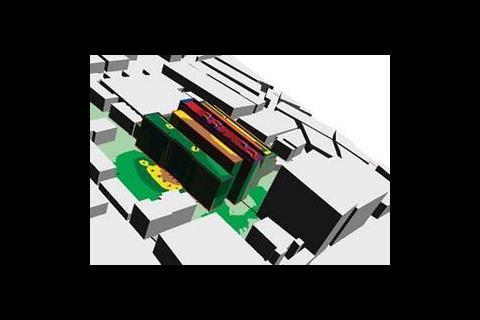Noise breakout from hvac installations needs careful consideration. We give an overview of the specification and implementation of noise control measures.
Noise breakout is a potential hurdle in the installation of any hvac system. Whether its from externally mounted plant or plant connected via louvres to outdoors, noise can affect neighbouring properties or the building it serves. Unless the installation is extremely remote or the noise from other activities, such as road traffic, is significant enough to drown it out, some consideration of environmental noise is required.
For new build schemes and some refurbishments, planning conditions relating to the control of noise emissions will usually be imposed by the local authority. The purpose of these conditions is normally to protect nearby noise sensitive properties, such as residences or schools, but in some instances it may also be to control the upward ‘creep’ of background noise levels.
Various standards are referenced by local authorities but the most commonly used is BS4142: 1997 – Rating Industrial noise affecting mixed residential and industrial areas. This relates to noise from industrial or commercial sources affecting residential properties.
The standard rates the noise output from the noise source against the prevailing background noise during the time of operation, and reviews this in terms of the likelihood that complaints will be made. There is a correction to be applied for tonal content or intermittency of operation of a system, due, for example to the cycling of condensing units; pure tone of compressors – which is a function of operating speed; blade passage frequency of a fan; or the firing up of a boiler.
The likelihood of complaint is assessed through a number of conditions set out in BS4142: 1997. These refer to a ‘difference’, which relates to the variation between the level of noise from the new source, (including corrections where applicable) and the background noise level. The criteria outline the following conditions:
- The greater this difference the greater the likelihood of complaints.
- A difference of around +10 dB or more indicates that complaints are likely.
- A difference of around +5 dB is of marginal significance. If the rating level is more than 10 dB below the measured background noise level, then this is a positive indication that complaints are unlikely.
Local authorities tend to vary greatly in their application of BS4142: 1997, and as such the conditions they impose on noise from new hvac plant can vary from 10 dB(A) below the background level to as much as 5 dB(A) above it.
At first inspection a criterion set at say 10 dB(A) below background may seem unreasonably onerous, however, from BS4142: 1997 this would be the only rating to provide a positive indication of no complaints. Many local authorities apply a ‘5 dB(A) below background’ condition that allows for a small increase in the ambient levels. There are numerous other interpretations and possible stipulations, including frequency specific criteria, which can be difficult to achieve without expensive noise control equipment. Once conditions are known, negotiations with the local authority can take place and when agreement has been reached, and operational noise limits for the plant set, a noise control strategy can be developed.
If a hvac installation fails to comply with the planning condition, the local authority can serve an abatement notice. A noise nuisance is not clearly defined in terms of decibels, the legislation instead refers to the ‘likely reaction of a reasonable person’. Certainly if a noise source was 10 dB(A) above background an environmental health officer would be able to act with absolute certainty that a noise nuisance existed. In normal circumstances an environmental health officer will firstly liaise with the building owner/occupier responsible for the noise nuisance and then, if no satisfactory remedial measures are implemented within a reasonable time, through resorting to statutory controls.
Complying with the criteria
So what are the problems that can arise when defining and attempting to comply with environmental noise criteria? Environmental noise criteria tend to be defined as dB(A) noise levels relative to the dB(A) level of the existing background noise level. The A-weighted system takes into consideration the human ear’s sensitivity to certain frequencies. The main drawback with this system is that it does not take account of strong tones. A broadband noise source is subjectively much more acceptable than the same A- weighted level that is dominated by a particular tone. An example of the difference between tonal and broadband noise at the same A-weighted level is shown in figure 3.
Background noise in most urban environments is dominated by road traffic noise, which is relatively broadband in nature. If tones or dominant frequency ranges in hvac noise are not masked by background noise at similar frequencies then they will be clearly audible and likely to attract complaints. For instance, in figure 4, the hvac noise although 10 dB(A) below the ambient background noise, is dominated by frequencies above 2 kHz that will be clearly audible and likely to cause complaints.
In the same way, low frequency tonal noise can be significant when compared with broadband noise of the same dB(A) level as shown in figure 5.
Low frequency noise is not always adequately considered in an A-weighting. Figure 5 shows that an excess of around 7 dB at 63 Hz could exist at the same A-weighted value when a low frequency source is contrasted with a typical broadband spectrum. A difference of 7 dB would be very noticeable and again likely to attract complaints.
It is therefore important to ensure that the frequency content of hvac noise is taken into account in the assessment of compliance with criteria, especially if a planning condition includes subjective requirements such as ‘inaudibility’.
It is always advisable to obtain a background noise survey even if the planning consent for a scheme does not specifically require one. The data can provide information on noise levels that are likely to be acceptable, demonstrate compliance with appropriate standards when the installation is complete and avoid some of the pitfalls discussed previously.
The client is then safeguarded against noise nuisance issues that could result in offending plant having to be shut down under an abatement notice.
The acoustic survey must be designed to obtain a representative set of lowest background noise levels that are likely to prevail at a site over a full year. In reality of course, most noise surveys are conducted over relatively short time periods and the challenge for the acoustician is in selecting the appropriate occasion and duration. Even measurements over one week will show large variations in the prevailing noise levels. A longer survey period will result in more accurate data and take into account variations in weather conditions that can seriously affect the results. The selection of measuring positions is also very important in obtaining useful information about the noise climate of the site.
Obviously if the plant does not operate on a 24-hour basis (and there is no prospect that it ever will), then the background noise level need only be that applying during its operating period.
Night operation of plant is normally the most critical as this is usually when lowest background noise levels occur. Even when a building is not used at night its plant is often operated then – for example, on night cooling strategies or under a frost protection override – so a lot of apparent ‘daytime only’ plant may need to be selected for night operation.
Noise mapping
It is normal good practice for a developer’s plant to be selected to come below the environmental noise considerations set down, allowing tenants a margin for noise from their own plant.
The issue becomes far more complex on developments with multi tenancy, such as large-scale retail schemes. They need very careful consideration of how the noise limit will need to be split between the landlord and amongst the various tenants so the overall noise does not exceed the requirements.
A typical scheme is shown in figure 1 with four acoustic index positions, (ie noise sensitive receiver locations), together with the propagation paths from noise sources – in this case each hvac plant location. The resultant noise level from each plant item is calculated at each position allowing for screening attenuation, air attenuation, ground absorption and distance effects as appropriate. The resultant noise levels at each acoustic index position is then determined through logarithmic addition of every sources effect. These noise levels can then be rated against background noise to determine the noise control measures required. Depending on complexity this can become quite an arduous task and one which also carries the risk of not necessarily identifying all the critical noise paths or indeed all of the noise sensitive receiver locations. The resultant noise figures also often require constant modification during design development as the plant selection or building structure changes.
Fortunately recent technology is making these kinds of complex ‘hand-cranked’ calculation routines a thing of the past. The advent of advanced noise mapping technology now provides an extremely detailed and accurate acoustic model for a development with complex services, and plant noise spectra.
Noise mapping software was not originally developed for this purpose but its flexibility readily lends itself to this use. Large sources such as chillers or cooling towers can be modelled as area sources and smaller plant items as point sources. The calculation process takes into consideration such factors as atmospheric effects and screening, and produces a detailed coloured grid in three dimensions as shown in figure 2 – the 100 000 m2 Bishops Square development in London.
The model was used to test and demonstrate compliance with the strict planning conditions imposed on the scheme. It provided the important additional benefit of enabling the various noise contributions from each plant item to be assessed at each noise sensitive location, so that dominant plant noise sources could be identified. Investment can then be focused specifically on the best value noise control measures needed to meet the environmental noise requirements.
One major advantage is that simple modifications and ‘tweaks’ can be applied and the results are immediately apparent for the complete scheme. This allows the noise control measures to be optimised and ensures there is no unnecessary expense. The model will also highlight various acoustic index locations that may not be apparent from the site location plan.
Breakout within buildings
While the consideration of the neighbours is very important, noise transmitted within the development or building which the plant serves must also be analysed.
It is worth noting that attenuation through building fabric at low frequencies is often poor and many plant noise sources such as centrifugal fans have much low frequency content. For instance, lightweight roof treatments, such as profiled metal deck with insulation and a membrane, offer minimal sound insulation. If a chiller operating at around 75 dB(A) – at 1 m – was installed above this type of roof, it would create an internal noise level of about 50 dB(A) or NR46. If it operated in conjunction with other plant internally, noise in the space below would become even more excessive. Further, the intermittent operation of a chiller and its possible pure tone noise characteristics make it a much less acceptable noise source than say broadband noise from a ventilation system.
Plant should be sited as far away as possible from both internal and external noise sensitive locations. This simple step can reduce substantially the cost of noise control measures. Inevitably plant must sometimes be situated, for very real reasons, close to residential boundaries or close to noise critical internal spaces. This makes good attenuation of the hvac, and the careful design of building elements such as floors, roofs and facades extremely critical.
Assessing needs
In these times there is an ever-increasing emphasis on the control of environmental noise from hvac plant. Compliance with strict planning conditions and control of noise transfer within buildings requires careful assessment that should include:
- Existing noise levels through surveys.
- Noise sensitive neighbours and areas within the building.
- Location of plant to minimise noise impact.
- Specification and detailed design of attenuation measures taking into account frequency content of the noise emissions.
- Specification and detailed design of building elements surrounding the plant areas.
In this way, the noise from hvac plant can be controlled so that its impact on the surrounding environment is minimised.
Jeremy Butt, CEng, MPhil, MIOA is an executive acoustic engineer with Hoare Lea Acoustics.
Source
��ɫ����TV Sustainable Design
























No comments yet